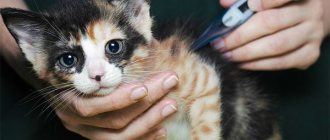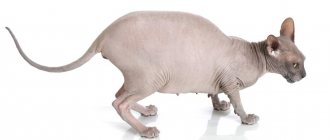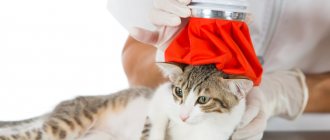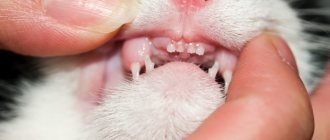It is useful for every responsible owner to know what the normal body temperature should be for cats and kittens. This important indicator is the main indicator of health, helping to identify the disease before dangerous changes occur. The deviations that arise are not always explained by pathology, therefore, in addition to the cat’s body temperature, it is necessary to take into account the accompanying symptoms and the general condition of the pet.
What temperature is considered normal for cats?
The body temperature of cats and cats is individual. First of all, it depends on metabolism, which varies depending on gender and age. Higher rates are typical for young males, and lower rates for older females.
In small kittens
A newborn kitten's temperature is the same as its mother's. In the first 3 weeks it gradually decreases to 35.5-36.5°C. The baby’s thermoregulation mechanism is still developing, so such fluctuations are absolutely normal.
From the 3rd week, the indicator begins to increase, reaching 38.5-39.5°C by 3-4 months. A kitten's temperature is higher than that of adult animals. This is due to active growth and mobility, which require a lot of energy.
In adult animals
Normal body temperature in adult cats is 37.5-38.9°C. Here it is important to remember about the individuality of the indicator. In addition to gender and age, the size of the animal also influences it. The larger they are, the less heat is required to heat and maintain internal processes.
If your pet’s normal temperature is 38.9°C, then a deviation to 39.2°C is not dangerous for him. The opposite situation is typical for a cat, whose normal temperature is 38°C. For her, a value of 39.2°C is an alarm bell, suggesting a mandatory examination by a veterinarian.
The most dangerous values are below 37°C and above 40°C. They are always associated with pathology and require emergency assistance from the owner.
Features of some breeds
A cat's body temperature is not affected by the amount of fur. This means that the norm for hairless breeds is identical to that of furry representatives. The increased warmth felt by the owners of sphinxes is associated with the absence of the usual layer of hair between the human palm and the animal’s skin.
Normal temperature for a cat
Cats have a higher metabolic rate than humans, so the physiological norm for adult animals is considered to be 37.5–39 °C. In kittens, an increase of another half degree is allowed. The upper limit of normal for young Sphinxes is exactly 40 °C.
So, the upper limit of normal for most adults is considered to be 39 degrees. When the increase is 1°C or less, the temperature is called low-grade fever. That is, 40 degrees for a cat corresponds to 37.5 for a person.
This increase can be explained by the error of the measuring device, high physical activity or chronic disease. In the latter case, additional clinical symptoms are detected.
When deviations are acceptable
Fluctuations are not always explained by pathological reasons. In the absence of alarming symptoms, they arise due to physiological processes and time of day. Such changes, amounting to about 0.5-1°C, are normal. They are short-term and should not cause panic in the owner.
Increasing values
If a cat has an elevated temperature, this condition is called hyperthermia. The upward deviation is due to the following reasons:
- Recent surgery or vaccination. A temperature jump occurs due to stress experienced by the body or activation of the immune system. Its duration should not exceed 3 days. Otherwise, you need to contact your veterinarian.
- Prolonged stress. In addition to anxiety after surgery, unpleasant feelings can be explained by the process of visiting the veterinary clinic itself. Stress is also caused by a long journey in transport, swimming, moving, the arrival of a new family member and other exciting events.
- Taking medications that affect the mechanism of thermoregulation. Before treatment, the veterinarian must clarify all side effects, including temperature fluctuations.
- Pregnancy. During pregnancy, the body works to the limit of its capabilities, supporting the vital functions of the mother and her babies. This is accompanied by an increase in the thermal index.
- Increased activity. Active games and running around the house take a lot of energy, so your pet needs extra energy.
- Recent feeding. Digestion also requires energy, which means it requires more energy than at rest. The energy produced by the body is converted into heat.
- Keep in a cold room. A kitten's temperature directly depends on the environment. If he is cold, his body can warm up to 40°C. Newborns should be heated to 31°C, and after they reach 3 weeks - to 24°C.
Fever due to physiological reasons does not exceed 1°C and is called low-grade fever. A more dangerous condition with an excess of up to 2°C is called febrile, and the most dangerous (more than 2°C) is called hyperpyretic.
Lowering values
A low temperature in a cat is called hypothermia. The reason for its appearance may be the following physiological reasons:
- Hypothermia. Frost and humidity are equally dangerous for your pet. Wet wool sticks together, negating the functionality of the air gap. A wet cat is even more vulnerable to drafts than a hairless cat. For the safety of the animal, do not let it go for walks in the rainy season.
- Poor nutrition. Not only overfeeding is dangerous for pets, but also underfeeding. An exhausted body is more vulnerable to infections and can provoke a relapse of chronic pathologies. If your pet is categorical about a new food, do not starve him, but offer an alternative.
- Dream. The reduced temperature in a sleeping animal is explained by a slowdown in internal processes. During sleep, less energy is used than usual. The low rate persists for some time after waking up until normal activity returns.
- Early birth. A day or several hours before the birth of the offspring, the usual value decreases within 1°C. It returns to normal only a couple of hours after the birth of all kittens. You should only worry if the change exceeds the specified value or persists longer than the specified time.
- Recent anesthesia. The anesthetic puts the animal into artificial sleep, causing a slowdown in internal processes.
- Times of Day. All representatives of the cat family are nocturnal animals. Their peak activity occurs closer to dusk, so you should not be surprised at the low rate in the morning.
If none of the reasons considered are suitable, then you should pay attention to pathological explanations. They can be recognized by the accompanying symptoms.
Pathological causes of deviations
Deviations over 1°C are typical for diseases. The longer a pet remains without treatment, the greater the likelihood of exceeding a critical level, which is fraught with negative consequences.
Promotion
If a cat has an elevated temperature due to pathology, then in most cases this is the result of the body’s fight against an infiltrated infection. With the help of heat, immunity creates conditions unfavorable for the life of microorganisms, killing them on the spot or forcing them to leave the host’s body forever.
In addition to infections caused by viruses, fungi or bacteria, hyperthermia occurs for the following reasons:
- Overheat. Prolonged exposure to direct sunlight is especially dangerous for kittens and older animals. If you do not follow the rules of care, your pet may develop heatstroke and sunstroke. This condition is very dangerous and requires immediate help. It can be recognized by vomiting, discoloration of mucous membranes, convulsions and loss of consciousness.
- Inflammation. This pathological process is a tool of protection. The body launches it in response to a pathogenic stimulus or damage. If the pet has recently undergone an injury or surgery, then the healing wound becomes a gateway for pathogens.
- Helminthiasis. Hyperthermia when infected with parasites often worries kittens. The reaction occurs due to toxins released by worms during their life.
- Poisoning from spoiled foods and excess salts. Free access to the trash, feeding food from the human table or cheap food are the main causes of food poisoning and gastrointestinal disorders.
- Tissue necrosis. One of the most dangerous conditions, fraught with complete organ failure.
The exact cause of the changes can only be found out after tests and examination at a veterinary clinic. The owner can only promptly detect the following symptoms:
- loss of appetite and apathy;
- intermittent breathing, shortness of breath and wheezing;
- vomiting and diarrhea;
- redness of the eyes and paleness of the oral mucosa;
- mild trembling and convulsions;
- dullness and tangled fur.
If these symptoms or other warning signs occur, you should immediately seek help. Prolonged deviation from the standard value can be fatal.
Demotion
With hypothermia, the animal becomes lethargic and constantly seeks sources of heat. His breathing and heartbeat slow down, his mucous membranes turn pale and his pupils dilate. In this condition, all the blood is directed to the most important organs - the heart and brain. Processes in other organs slow down, and the limbs become cold due to lack of blood.
Some causes of hypothermia and hyperthermia are identical. These include:
- infections;
- poisoning;
- helminthiases.
Also, the slowdown of internal processes is affected by heavy blood loss, oncology, disorders in the cardiovascular, nervous and endocrine systems. The most dangerous deviation is below 28°C. It is almost impossible to save an animal in this condition.
Causes of elevated temperature
global $ads_google;
//data-ad-slot=”2475549904″ $ads_google = empty($ads_google) ? false : true; ?> if ($ads_google == false) {?> $ads_google = true; ?> } ?> Hyperthermia has its own causes: most often these are diseases caused by viruses or bacteria. For a small kitten, an increase in body temperature of 2 degrees can be fatal. In children, the cause of exceeding the indicator is sometimes worms.
In addition to viral and bacterial infections, the list of causes includes poisoning from stale food, and even excess salts in the body. Due to excess salts, the breakdown of proteins and tissues begins.
Parasites poison the body with toxins, to which the immune system responds by increasing temperature levels.
Medicinal causes include the body’s reaction to the administration of substances that excite thermoregulation centers in the brain.
Fever can be subfebrile (excess of 1 °C above normal), febrile (2 °C), hyperpyretic (over 3 °C).
The temperature rises slightly during exercise, eating and pregnancy.
How to measure a cat's body temperature
A rectal thermometer is used for measurements. It is recommended to purchase a device designed specifically for animals. Conventional mercury thermometers are dangerous because they can be damaged directly in the anus.
To measure you will need:
- Find an assistant. Cats do not like suspicious manipulations with their bodies. Without a partner, it will be difficult to restrain your pet without harming it.
- Treat the end of the thermometer with an antiseptic and lubricate it with Vaseline.
- Secure the cat lying on its side or standing, placing one of your hands under its belly. With your free hand, you need to gently hold your neck, fixing the position of your head. An overly aggressive pet can be wrapped in thick cloth to prevent injury from teeth or claws.
- Lubricate the animal's anus with Vaseline. A rich cream will also work.
- Gently lift the cat's tail and insert the device 2-3 cm with rotational movements. The depth of insertion depends on age. For kittens, 0.5-1 cm is enough. The main thing is to immerse the metal or rubberized tip inside.
- Wait for a signal from the electronic thermometer or mark 3 minutes.
- Treat the device with an alcohol-containing solution after removal.
An alternative option is to use an infrared ear thermometer. The advantage of this device is the measurement speed - only 10 seconds. The downside is that with ear inflammation there is a high error rate.
If you don't have a thermometer at home, you can use a cat's nose - another convenient indicator of health. A healthy pet's nose is always wet and cool. Dryness and warmth not associated with sleep or recent activity indicate hyperthermia. Additional indicators are hot ears or leathery paw pads.
How to measure a cat's temperature correctly
For thermometry in cats, the same measuring instruments are used as in humans. This may be an ordinary mercury thermometer, but not all animals tolerate the procedure calmly, and the glass device may be damaged, which is quite dangerous not only for the animal, but also for all people living in the apartment.
It is better to use an electronic thermometer, but you need to take into account that it has a fairly large measurement error (from one to five tenths of a degree).
It is recommended that the cat owner purchase a measuring device that will be used only for thermometry in the animal, but you can also use a general thermometer.
The thermometer is inserted rectally, that is, into the rectum. Animals react quite sharply to this procedure, so before carrying out it it is necessary to take measures against bites and scratches. In extreme conditions from a cat's point of view, they can show remarkable strength and dexterity, defending themselves, and one owner cannot cope.
It is best if one person fixes the animal, and the second one carries out the procedure. If the cat is large and shows serious dissatisfaction, it may take two people just to restrain it.
To secure the animal's body, you can use a towel: wrap the cat tightly, leaving the back of the body free, but wrapping the hind legs. One person takes the pet in his arms, and the second inserts a thermometer. You can do without fixing fabric, simply holding the front paws with one hand and pressing the withers to a hard horizontal surface with the other.
The working end of the measuring device is lubricated with some material that provides better gliding (cream, Vaseline) and inserted into the anus to a depth not exceeding 2 cm (the kitten should insert a thermometer to a depth of 1 cm).
This must be done carefully and delicately so as not to cause unnecessary suffering to the pet.
Electronic thermometers have a temporary advantage over conventional mercury thermometers; in addition, a buzzer sounds at the end of the measurement.
The mercury thermometer must be held inside the cat's body for 4-5 minutes, which makes the procedure very difficult, especially if the animal is very unhappy or aggressive.
Upon completion, it is necessary to remove the device, evaluate the indicators, and compare them with normal ones. The working end must be treated with a disinfectant. When assessing, you should take into account the cat's behavior during the procedure: if she resists very strongly, then she becomes stressed, and therefore the temperature rises.
Especially in order to make life easier for cats and protect them from stress, thermometers were developed that can be used to measure temperature without causing severe discomfort. Such devices are infrared thermometers.
There are two types of such devices: ear-based and non-contact. In the latter case, the cat does not experience any sensations at all during the procedure. The tool is simply pointed at the animal’s body, after which the result is immediately obtained.
The measurement error is small: only 0.2-0.3 degrees, but the cost of such devices is very high.
Infrared ear thermometers are also not cheap, and their use also does not cause discomfort to your pet. They are inserted shallowly into the ear and quickly show results, but the answer may be distorted if the cat has some ear pathologies.
How to help yourself
If you suspect a pathology, it is better to immediately contact a veterinarian. If this is not possible or the pet’s condition does not cause concern, then first aid can and should be provided independently.
How to bring down the temperature
For minor changes, re-measurement should be done after a few hours. If the thermometer immediately shows 40°C or values close to it, then you need to act immediately. In such a situation, you can try to lower the number on the thermometer in the following ways:
- Place the animal in a cool and ventilated area. Open doors and windows to avoid restricting air flow.
- Wetting wool. Wet your pet's coat with water or wrap it in wet gauze.
- Applying a cold compress. Dampen a towel or napkin with cold water and apply it to your neck, inner thighs and groin. Change the compress when heating. Instead of water, you can use ice cubes wrapped in thick cloth.
- Drink plenty of fluids. If the cat refuses to drink on his own, drink it from a syringe.
- Lubricating paw pads. Use a vinegar solution diluted with water in a ratio of 1:3.
If you have no appetite, do not try to force feed your pet. If interest in food continues, use light chicken broth to avoid dehydration.
It is better not to take medicinal herbs, antibiotics and antipyretics without a doctor’s prescription. They can cause allergies, intoxication and even death.
How to raise the temperature
With hypothermia, the main task of the owner is to warm up his pet in any way. To do this you will need:
- bring the animal from the street into a warm room, protected from drafts;
- dry the wet wool with a towel or hairdryer;
- wrap the cat in a warm blanket and cover it with heating pads (ordinary plastic bottles with hot water wrapped in thick fabric will also work);
- Give your pet warm water, milk or broth.
A warm cat should fall asleep. If his condition improves after sleep, give him something to eat.
Reasons for the drop in temperature
Hypothermia is no less dangerous for an animal. Due to the decrease in temperature in the body, metabolic processes slow down. Outwardly, such a cat notices a decrease in activity and shallow breathing, and the need to search for a warm place. These symptoms are similar to the manifestations of fever during hyperthermia, and the drop in temperature can only be determined with a thermometer.
Temperature in dogs. Temperature in cats. How to bring down the temperature. Reasons for the increase
Hypothermia occurs due to general hypothermia when the animal is outside for a long time in the cold. With high humidity and precipitation, a cat can freeze even in a relatively warm season: wet fur does not protect it from wind and heat loss over the entire surface of the body. Weakened animals freeze faster. In addition to physiological reasons, hypothermia occurs due to the following reasons:
- Diseases of internal organs. Elderly animals are susceptible to hypothermia due to hidden pathologies of the liver or kidneys (urolithiasis, etc.), which are difficult for a non-specialist to notice.
- Infections of viral origin. Some types of pathogens suppress the immune system, and it does not respond with an increase in body temperature.
- Bleeding. Internal ones are especially dangerous: they are determined only by examining the contents of the tray for the presence of blood. Bleeding can be caused by injury or pathology, so the animal needs urgent help.
- Cardiovascular abnormalities. In this case, hypothermia is accompanied by severe symptoms of shortness of breath, arrhythmia, pale or bluish mucous membranes of the mouth.
- Postoperative condition. A common reaction to abdominal surgery during sterilization. The reason is the use of anesthesia and blood loss. The temperature will return to normal in 2-3 days if healing proceeds normally.
Prolonged hypothermia can cause irreversible changes in the tissues of the brain, kidneys, lungs and other organs. If a cat’s temperature does not exceed +37... +38°C or within a short time drops to a critical +36.5°C, then it must be warmed up (use a heating pad with warm water or a heated blanket) and urgently taken to the veterinarian.
All information posted on the site is provided in accordance with the User Agreement and is not a direct instruction to action. We strongly recommend that before using any product, you must obtain a face-to-face consultation at an accredited veterinary clinic.











